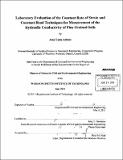| dc.contributor.advisor | John T. Germaine. | en_US |
| dc.contributor.author | Adams, Amy Lynn | en_US |
| dc.contributor.other | Massachusetts Institute of Technology. Dept. of Civil and Environmental Engineering. | en_US |
| dc.date.accessioned | 2011-11-01T19:53:57Z | |
| dc.date.available | 2011-11-01T19:53:57Z | |
| dc.date.copyright | 2011 | en_US |
| dc.date.issued | 2011 | en_US |
| dc.identifier.uri | http://hdl.handle.net/1721.1/66859 | |
| dc.description | Thesis (S.M.)--Massachusetts Institute of Technology, Dept. of Civil and Environmental Engineering, 2011. | en_US |
| dc.description | Cataloged from PDF version of thesis. | en_US |
| dc.description | Includes bibliographical references (p. 185-187). | en_US |
| dc.description.abstract | This thesis evaluates the constant rate of strain and constant head techniques for measurement of the hydraulic conductivity of fine grained soils. A laboratory program compares hydraulic conductivity measurements made using both measurement techniques on a total of 12 specimens. Both resedimented and intact materials covering a wide range of plasticity are investigated. Specific material types include Boston Blue Clay, San Francisco Bay Mud, Maine Clay, Ugnu Clay and Kaolinite. Constant rate of strain (CRS) and constant head tests were conducted in a standard Trautwein CRS device modified to allow control of the base pore pressure for constant head testing. A flexible wall permeameter device was used to perform constant head hydraulic conductivity testing on two specimens; this allowed for comparison with the constant head measurements made in the CRS device. A bottom seating error was found in the CRS device. Bottom seating error occurs during set up when the top of the base porous stone is not flush with the bottom of the rigid specimen ring, causing a gap to form between the specimen and the porous stone. A bottom seating error translates into a strain error, which affects both the measured CRS compression and hydraulic conductivity results. Bottom seating error can be avoided using a modified set up procedure. Void ratio errors are sometimes noted between the void ratio measured in the CRS device and that measured upon removal from the CRS device. These errors are likely resultant from specimen swelling following load removal. Based on comparison to the results of an interlaboratory study into the reproducibility of the saturated hydraulic conductivity measured in a flexible wall permeameter, the CRS and constant head techniques were found to measure the same hydraulic conductivity. This conclusion is independent of specimen origin, i.e. resedimented or intact. The CRS and constant head techniques measure the same average hydraulic conductivity even when non uniformities are present, provided the non uniformities are continuous and oriented perpendicular to the axial loading direction. | en_US |
| dc.description.statementofresponsibility | by Amy Lynn Adams. | en_US |
| dc.format.extent | 203 p. | en_US |
| dc.language.iso | eng | en_US |
| dc.publisher | Massachusetts Institute of Technology | en_US |
| dc.rights | M.I.T. theses are protected by
copyright. They may be viewed from this source for any purpose, but
reproduction or distribution in any format is prohibited without written
permission. See provided URL for inquiries about permission. | en_US |
| dc.rights.uri | http://dspace.mit.edu/handle/1721.1/7582 | en_US |
| dc.subject | Civil and Environmental Engineering. | en_US |
| dc.title | Laboratory evaluation of the constant rate of strain and constant head techniques for measurement of the hydraulic conductivity of fine grained soils | en_US |
| dc.type | Thesis | en_US |
| dc.description.degree | S.M. | en_US |
| dc.contributor.department | Massachusetts Institute of Technology. Department of Civil and Environmental Engineering | |
| dc.identifier.oclc | 758153419 | en_US |
